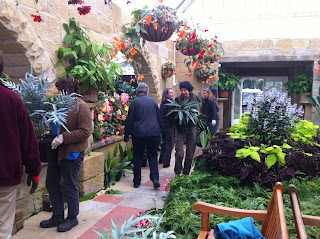Today it was all about soil - the different compositions (sand, silt or clay) and rock types that form the substructure that breaks down to give the overall mineral soil type.
 |
| Inside the Education Pod - our cosy classroom. |
After a light introduction in the classroom we headed out with Marcus for some evaluations of different soil types and the different characteristics of the three main rock types found in the greater Hobart area Basalt, Dolerite and Granite.
 |
| Heading up to the Domain |
In the upper bus car park we could look at a slice of the bank which showed all the layers of the soil. This really helped me to visualise what is happening under the ground. Starting at the top there is the 'A' Horizon level which consists of your "topsoil" and whatever is growing in it. Just below this is the Sub 'A' Horizon level/s consisting of the smaller ground up particles of the bed rock mixed with the top soil and humus. Below this is the bed rock. NOTE: it's very important to ascertain with any site what soil type and bedrock you are working with to choose your best plants/trees for that site and avoid problems with drainage etc...
I find this all really interesting but get a bit confused sometimes identifying different rock types. Quartz and Sandstone are easy, but Basalt and Dolerite (in the ground not the blue metal gravel) can be a bit tricky. Will hopefully pick this up as we continue on..........
 |
| Marcus with a 'male' Allocasurina - Sheeoak |
Along the way we also did a spot of Plant Naming. I learnt to identify the male versus female
Allocasurina. We also discussed the Compound leaves of the Silver Wattle
Acacia dealbata which is made up of a group of Pinnate leaf types which in turn makes up the Paripinnate Compound Leaf (even number of leaflets attached to the Rachis ). If there were an odd number of leaflets it would be known as an Imparipinnate Compound Leaf. Right...... I think that has definitely sunk in now!


















